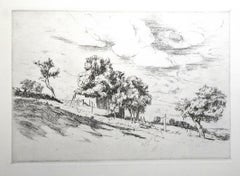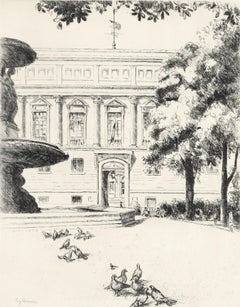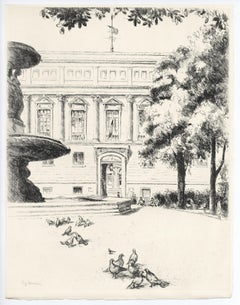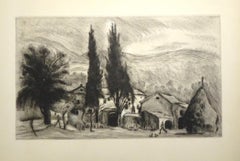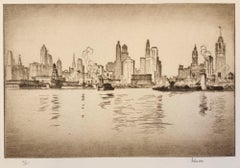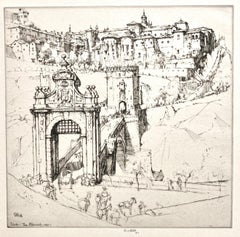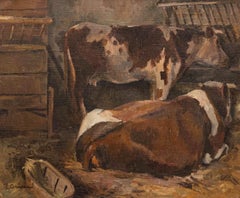Eugene Corneau Art
to
1
6
1
Overall Width
to
Overall Height
to
7
5
6
5
2
7
3
2
2
1
1
1
5
5
5
7
7,820
5,167
2,504
1,501
2
2
Artist: Eugene Corneau
Untitled - Original Drypoint by Eugene Corneau - XX Century
By Eugene Corneau
Located in Roma, IT
Untitled is an original artwork realized by Eugène Corneau during the 1930s.
Etching and drypoint on paper. Monogram in pencil on the lower left.
Excellent conditions.
Precious an...
Category
20th Century Modern Eugene Corneau Art
Materials
Drypoint
La Bibliothèque nationale, A La gloire à Paris, Eugène Corneau
By Eugene Corneau
Located in Auburn Hills, MI
Etching on vélin Canson et Montgolfier paper. Unsigned and unnumbered, as issued. Good condition. Published by L'Imprimerie Daragnès, Paris; printed by Jean Gabriel Daragnès, Paris, ...
Category
1930s Modern Eugene Corneau Art
Materials
Etching
French Village - Original Etching and Drypoint by Eugène Corneau - 1930s
By Eugene Corneau
Located in Roma, IT
French Village is an original artwork realized by Eugène Corneau between the end of the 1920s and the beginning of the 1930s.
The monogram of the artist is present on the lower left...
Category
1930s Modern Eugene Corneau Art
Materials
Drypoint, Etching
Untitled - Original Etching and Drypoint by Eugène Corneau - 1930s
By Eugene Corneau
Located in Roma, IT
Untitled is an original artwork realized by Eugène Corneau in the first years of the 1930s. Etching and drypoint on paper. Monogram of the artist on the lower left. Excellent conditi...
Category
1930s Modern Eugene Corneau Art
Materials
Drypoint, Etching
"La Bibliotheque Nationale" original etching
By Eugene Corneau
Located in Henderson, NV
Medium: original etching. This impression on Canson et Montgolfier wove paper was printed in 1937 in an edition of 500 for the "Paris 1937" portfolio. Printed at the atelier of Jean-...
Category
1930s Eugene Corneau Art
Materials
Etching
French Village - Original Drypoint by Eugene Corneau - XX Century
By Eugene Corneau
Located in Roma, IT
French Village is an original artwork realized by Eugène Corneau at the beginning of the 1930s.
Drypoint and etching on paper.
Perfect conditions.
Th...
Category
20th Century Modern Eugene Corneau Art
Materials
Drypoint
French Landscape - Original Etching by E. Corneau - 1930s
By Eugene Corneau
Located in Roma, IT
French Landscape is an original artwork realized by Eugène Corneau during the 1930s.
Etching and drypoint on paper.
Very good conditions except for some small folds on the left mar...
Category
1930s Modern Eugene Corneau Art
Materials
Drypoint, Etching
Related Items
Chicago Skyline
By Paul Schumann
Located in Middletown, NY
A beautiful turn-of-the-century lake view of Chicago by an American artist known for his Texas landscapes.
Etching with drypoint on watermarked Umbria laid paper with deckle edges, 7 1/4 x 10 7/8 inches (182 x 275 mm), full margins. Signed and numbered 4/25 in pencil, lower margin. In good condition with adhesive residue at the sheet edges on the verso, does not show through to the recto. A lovely Lake Michigan landscape...
Category
Early 20th Century American Modern Eugene Corneau Art
Materials
Handmade Paper, Etching, Drypoint
Ernest David Roth, Toledo, The Approach
By Ernest David Roth
Located in New York, NY
Working in the tradition of the Etching Revival, Ernest David Roth made this amazingly conceived and detailed study of the entrance to the Spanish ci...
Category
Early 20th Century American Modern Eugene Corneau Art
Materials
Etching
Low Country (South Carolina)
By Elizabeth Verner
Located in Middletown, NY
An enchanting Southern landscape by the mother of the Charleston Renaissance, Elizabeth O'Neill Verner(1883-1979)
Etching and drypoint on cream wove paper, 6 15/16 x 5 1/16 inches (175 x 128 mm), full margins. Signed, titled and numbered 72/100 in pencil, lower margin. Uniform age tone, minor surface soiling. A rich and inky impression of a magical southern landscape with figure tilling soil under Spanish moss covered oaks.
A native of Charleston, South Carolina...
Category
1930s American Modern Eugene Corneau Art
Materials
Drypoint, Etching
Art Deco Etching "Zest" by Louis Icart
By Louis Icart
Located in Berlin, DE
Etching by Louis Icart ( 1888-1950 ), France. 1928. Signed in pencil lower right: Louis Icart.
Dated top left: Copyright 1928 by L. Icart Paris. Decorative frame. Dimensions: 19.29 ...
Category
Early 20th Century Art Deco Eugene Corneau Art
Materials
Etching
Tugs on the Hudson
By Charles Frederick William Mielatz
Located in Middletown, NY
Drypoint etching with engraving printed in black ink on Japanese mulberry paper, 4 1/2 x 3 3/8 inches (113 x 84 mm), full margins. In superb condition. A beautiful New York City river...
Category
Early 20th Century American Modern Eugene Corneau Art
Materials
Handmade Paper, Drypoint, Etching
Paul Klee Etching "Die Szene mit der Laufenden"
By (after) Paul Klee
Located in Berlin, DE
Helio-etching on hand-made paper, 1925 by Paul Klee. Signatur is printed, lower right: Klee
From portfolio Paul Klee, Handzeichnungen 1921-1930; Here no 28
Image: 5.63 x 7.48 in ( 14...
Category
Early 20th Century Expressionist Eugene Corneau Art
Materials
Etching
Paul Klee Etching "Möchten sollen"
By Paul Klee
Located in Berlin, DE
Helio-etching on hand-made paper, 1927 by Paul Klee. From portfolio "Paul Klee, Handzeichnungen 1921-1930" Here no 41
Measurements: Image: 5.51 x 7.48 in ( 14 x 19 cm ), Framed: 13.4...
Category
Early 20th Century Expressionist Eugene Corneau Art
Materials
Etching
Werner Drewes, 125th Street at Broadway, NYC
By Werner Drewes
Located in New York, NY
Werner Drewes brought his modernist vision to this subject but created, in my opinion, a great work of the Etching Revival.
The reference is Rose 183. It...
Category
1930s American Modern Eugene Corneau Art
Materials
Drypoint
Low Country (South Carolina)
By Elizabeth Verner
Located in Middletown, NY
An enchanting Southern landscape by the mother of the Charleston Renaissance.
A native of Charleston, South Carolina, and educated under the tutelage of Thomas Anshutz at The Pennsylvania Academy of Fine Arts, O'Neill Verner was a teacher, a mother, an artist, an ardent preservationist, and a skilled autodidact. Having previously focused on painting, in the early 1920s she found herself deeply moved by printmaking as a media, and especially so by the simple, peaceful themes and tableaus she discovered in Japanese art. She embarked on a effort to teach herself Japanese printmaking techniques, and in the process, produced the charming images of every day life in Charleston and its environs that earned her recognition as a cultural icon in her day, and in more modern times, as the mother of the Charleston Renaissance, which flourished well into the 1930s. In 1923 she opened a studio in Charleston where she focused on documenting the local color and the architecture and landscape that distinguishes Charleston as one of the South's most beautiful cities, all the while applying the gentle and poetic thematic sensibilities of Japanese printmaking. O'Neill Verner soon found herself in high demand when municipalities and institutions throughout the country sought commissions from her to document the beauty of their grounds and historic buildings. She worked as far north as the campuses of Harvard and Princeton, and extensively across the South, including in Savannah, Georgia, where through sweeping commissions she was able to marry her love of southern preservation and art. O'Neill Verner was a lifelong learner, and continued a path of edification that led her to study etching at the Central School of Art in London, to travel extensively through Europe, and to visit Japan in 1937, where she studied sumi (brush and ink) painting. She was a founding member of the Charleston Etchers Club, and the Southern States Art League. Her works are represented in the permanent collections of leading museums across the American south, and in major national institutions including the Metropolitan Museum of Art, Boston's Museum of Fine Art, and the Smithsonian American Art Museum. O'Neil Verner...
Category
Early 20th Century American Modern Eugene Corneau Art
Materials
Archival Paper, Drypoint, Etching
IV unique Printers Proof Color field geometric abstraction pencil signed pochoir
By Larry Zox
Located in New York, NY
Larry Zox
Untitled IV, ca. 1979
Pochoir on Arches Paper with Deckled Edges. Hand signed and annotated Printers Proof in pencil on the lower front.
28 1/2 × 22 1/2 inches
Unframed
This beautiful Larry Zox pochoir on Arches paper with deckled edges a unique Printers Proofs - signed by the artist in pencil on the lower front.
We do not know the size of the regular edition, or whether there is a regular edition, but this is indeed a unique PP.
LARRY ZOX BiIOGRAPHY
A painter who played an essential role in the Color Field discourse of the 1960s and 1970s, Larry Zox is best known for his intensely and brilliantly colored geometric abstractions, which question and violate symmetry. Zox stated in 1965: “Being contrary is the only way I can get at anything.” To Zox, this position was not necessarily arbitrary, but instead meant “responding to something in an examination of it [such as] using a mechanical format with X number of possibilities.”[2] What he sought was to “get at the specific character and quality of each painting in and for itself,” as James Monte stated in his introductory essay in the catalogue for Zox’s 1973–74 solo exhibition at the Whitney Museum of American Art.[3] Zox also at times used a freer, more intuitive method, while maintaining coloristic autonomy, which became increasingly important to him in his later career.
Zox began to receive attention in the 1960s, when he was included in several groundbreaking exhibitions of Color Field and Minimalist art, including Shape and Structure (1965), organized by Henry Geldzahler and Frank Stella for Tibor de Nagy, New York, and Systemic Painting (1966), organized by Lawrence Alloway for the Guggenheim Museum. In 1973–74, the Whitney’s solo exhibition of Zox’s work gave recognition to his significance in the art scene of the preceding decade. In the following year, he was represented in the inaugural exhibition of the Hirshhorn Museum, which acquired fourteen of his works.
Zox was born in Des Moines, Iowa. He attended the University of Oklahoma and Drake University, and then studied under George Grosz at the Des Moines Art Center. In 1958, Zox moved to New York, joining the downtown art scene. His studio on 20th Street became a gathering place for artists, jazz musicians, bikers, and boxers. He occasionally sparred with visiting fighters. He later established a studio in East Hampton, a former black smithy used previously by Jackson Pollock.
Zox’s earliest works were collages consisting of pieces of painted paper stapled onto sheets of plywood. He then produced paintings that were illusions of collages, including both torn- and trued-edged forms, to which he added a wide range of strong hues that created ambiguous surfaces. Next, he omitted the collage aspect of his work and applied flat color areas to create more complete statements of pure color and shape. He then replaced these torn and expressive edges with clean and impersonal lines that would define his work for the next decade.
From 1962 to 1965, he produced his Rotation series, at first creating plywood and Plexiglas reliefs, which turned squares into dynamic polygons. He used these shapes in his paintings as well, employing white as a foil between colors to produce negative spaces that suggest that the colored shapes had only been cut out and laid down instead of painted. The New York Times noted in 1964: “The artist is hip, cool, adventurous, not content to stay with the mere exercise of sensibility that one sees in smaller works.”[4]
In 1965, he began the Scissors Jack series, in which he arranged opposing triangular shapes with inverted Vs of bare canvas at their centers that threaten to split their compositions apart. In several works from this series, Zox was inspired by ancient Chinese water vessels. With a mathematical precision and a poetic license, Zox flattened the three dimensional object onto graph paper, and later translated his interpretation of vessel’s lines onto canvas with masking tape, forming the structure of the painting.
The Diamond Cut and Diamond Drill paintings...
Category
1970s Color-Field Eugene Corneau Art
Materials
Etching, Pencil, Monoprint
Paul Klee Etching "Beladene Kinder"
By Paul Klee
Located in Berlin, DE
Helio etching on hand-made paper, 1930 by Paul Klee. From portfolio " Paul Klee, Handzeichnungen 1921-1930. Here no 64.
Image: 7.4 x 5.71 in ( 18,8 x 14,5 cm ), Framed: 15.16 x 13.4...
Category
Mid-20th Century Expressionist Eugene Corneau Art
Materials
Etching
Four Original Signed Etchings by Louis Jou
By Louis Jou
Located in Paonia, CO
Spanish painter, engraver, master typographer and editor Louis Jou ( 1882 – 1968 ) became a naturalized French citizen and was known as an artist of the French School . He set up his own publishing house in Paris and gained a reputation as one of the greatest typographers of the 19th century. His original etchings and wood engravings appeared in books authored by Victor Hugo, Andre Gide, Cervantes and many more. Jou’s etchings also appeared in the Gazette des Beaux Arts published in Paris. Beginning in 1859 until it’s final year in 1930 the Gazette became known for it’s role in the revival of etching as a creative process as vital as painting and sculpture. The Gazette regularly commissioned the greatest etchers of the time including such artist’s such as Whistler, Goya, Max Lieberman...
Category
20th Century Expressionist Eugene Corneau Art
Materials
Etching
Previously Available Items
Eugène Corneau (1894-1976) - Mid 20th Century Oil, The Cowshed
By Eugene Corneau
Located in Corsham, GB
Signed to the lower right. On canvas on stretchers.
Category
20th Century Eugene Corneau Art
Materials
Oil
Marine - Original Etching by E. Corneau - 1930s
By Eugene Corneau
Located in Roma, IT
Marine is an original artwork realized by Eugène Corneau at the beginning of the 1930s.
Colored etching on paper.
Perfect conditions.
The artwork is one of the rarest examples of ...
Category
1930s Eugene Corneau Art
Materials
Drypoint, Etching
Eugene Corneau art for sale on 1stDibs.
Find a wide variety of authentic Eugene Corneau art available for sale on 1stDibs. You can also browse by medium to find art by Eugene Corneau in drypoint, engraving, etching and more. Much of the original work by this artist or collective was created during the 20th century and is mostly associated with the modern style. Not every interior allows for large Eugene Corneau art, so small editions measuring 13 inches across are available. Customers who are interested in this artist might also find the work of Pierre Quentin Chedel, Pierre Puvis de Chavannes, and Maxime Lalanne. Eugene Corneau art prices can differ depending upon medium, time period and other attributes. On 1stDibs, the price for these items starts at $145 and tops out at $201, while the average work can sell for $178.
